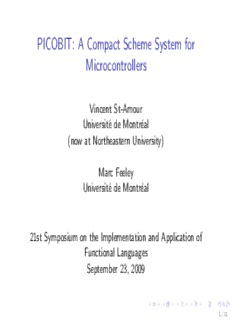
Vincent St-Amour PDF
Preview Vincent St-Amour
PICOBIT: A Compact Scheme System for Microcontrollers Vincent St-Amour Universit´e de Montr´eal (now at Northeastern University) Marc Feeley Universit´e de Montr´eal 21st Symposium on the Implementation and Application of Functional Languages September 23, 2009 1/31 Outline ◮ Motivation: small embedded systems ◮ System components ◮ The PICOBIT Scheme compiler ◮ The PICOBIT virtual machine ◮ The SIXPIC C compiler ◮ Experimental results ◮ Future work 2/31 Small embedded systems ◮ High volume ◮ Low cost ($1-$5 per microcontroller) ◮ Low memory (8-32 kB ROM 1-4 kB RAM) ◮ Low computational power (10 MIPS, 10 mW) ◮ Think microwave ovens, simple robots 3/31 Present state of affairs ◮ C or assembly ◮ Low level of abstraction ◮ Manual memory management ◮ Unsafe 4/31 Enter PICOBIT ◮ Scheme ◮ Automatic memory management ◮ Closures and higher-order functions ◮ First-class continuations ◮ Lightweight threads ◮ Built-in data structures ◮ Bignums ◮ Safety 5/31 The PICOBOARD robot 6/31 Goals ◮ Complex applications ◮ Low speed requirements ◮ Low memory footprint ◮ Compact code 7/31 Overview ◮ PICOBIT Scheme compiler ◮ Written in Scheme ◮ Compact custom instruction set ◮ PICOBIT virtual machine ◮ Written in C ◮ Highly portable ◮ SIXPIC C compiler ◮ Written in Scheme ◮ Designed for VMs 8/31 General approach ◮ Omit useless features ◮ Optimizations for code size ◮ High-level bytecode ◮ Controlling the whole pipeline ◮ Adapt the bytecode ◮ Domain-specific optimizations 9/31 Different flavors ◮ Full PICOBIT ◮ 15.6 kB ◮ PICOBIT without bignums ◮ 11.6 kB ◮ PICOBIT Light ◮ 5.2 kB ◮ No bignums ◮ No byte vectors ◮ Limited to 16 global variables ◮ Limited to 128 heap objects 10/31
Description: